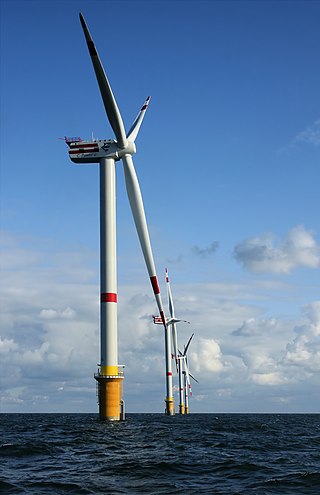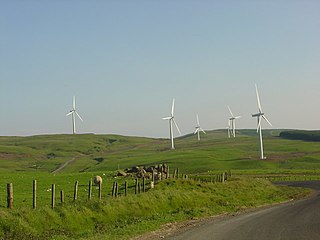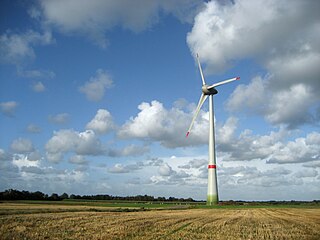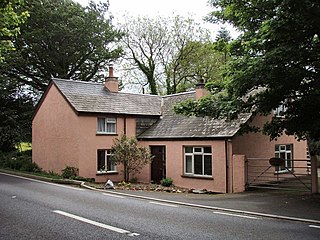
Enercon GmbH is a wind turbine manufacturer based in Aurich, Lower Saxony, Germany. It has been the market leader in Germany since the mid-1990s. Enercon has production facilities in Germany, Brazil, India, Canada, Turkey and Portugal. In June 2010, Enercon announced that they would be setting up Irish headquarters in Tralee.

Albany wind and Grasmere farms are two wind power stations near Albany, Western Australia, owned by Bright Energy Investments. They are adjacent and are often considered a single facility. They have 18 wind turbines, with a maximum generating capacity of 35.4 MW of electricity. The original Albany Wind Farm was commissioned in October 2001, after ten years of planning. The wind farm has the capacity to produce 80 per cent of the electricity requirements of Albany.

The Mendota Hills Wind Farm is a wind farm in Lee County, Illinois near the village of Paw Paw. It operates 29 wind turbines. Each wind turbine stands 214 ft tall and has three 85 ft long blades. The wind farm was constructed from June 2003 to November 24, 2003. Mendota Hills was the first utility-scale wind farm in the state of Illinois.
Wind power in Ohio has a long history, and as of 2016, Ohio has 545 megawatts (MW) of utility-scale wind power installations installed, responsible for 1.1% of in-state electricity generated. Over 1000 MW more were under construction or pending approval. Some installations have become tourist attractions. There has been a sudden increase in generating capacity, as the total wind power capacity in the state was just 9.7 MW in 2010. By 2019, there were 738 MW of capacity, which generated 1.71% of Ohio's electricity.

Wind power generates about 10% of Turkey's electricity, mainly in the west in the Aegean and Marmara regions, and is gradually becoming a larger share of renewable energy in the country. As of 2023, Turkey has 11 gigawatts (GW) of wind turbines. The Energy Ministry plans to have almost 30 GW by 2035.

Whitelee Wind Farm is a windfarm on the Eaglesham moor in Scotland. The main visitor centre is located in East Renfrewshire, but the majority of turbines are located in East Ayrshire and South Lanarkshire. It is the largest on-shore wind farm in the United Kingdom with 215 Siemens and Alstom wind turbines and a total capacity of 539 megawatts (MW), with the average of 2.5 MW per turbine. Whitelee was developed and is operated by ScottishPower Renewables, which is part of the Spanish company Iberdrola.

Biglow Canyon Wind Farm is an electricity generating wind farm facility in Sherman County, Oregon, United States. It is owned by Portland, Oregon-based Portland General Electric and began operations in 2007. With the completion of phase 3 of the project it has a generating capacity of 450 megawatts. It is located roughly five miles (8 km) northeast of Wasco, Oregon, and about ten miles (16 km) southeast of Rufus, Oregon. Biglow Canyon Wind Farm covers 25,000 acres (10,000 ha) in the Columbia River Gorge.

Burton Wold Wind Farm is a wind farm located near Burton Latimer in the English county of Northamptonshire, UK. The farm was developed by Your Energy Ltd, is owned by Mistral Windfarms and operated by Engineering Renewables Ltd. E.ON UK is buying the electricity output of the project under a long-term power purchase agreement. The farm is spread over three hectares. It has an installed capacity of 20 MW and generate on average around 40,000,000 units of electricity annually.

Carno is a wind farm of 68 turbines which started operation in October 1996. It covers an area of over 600 hectares on Trannon Moor, a plateau to the west of the village of Carno in Powys, Mid Wales, 400 metres (1,300 ft) above sea level.

A wind turbine is a device that converts the kinetic energy of wind into electrical energy. As of 2020, hundreds of thousands of large turbines, in installations known as wind farms, were generating over 650 gigawatts of power, with 60 GW added each year. Wind turbines are an increasingly important source of intermittent renewable energy, and are used in many countries to lower energy costs and reduce reliance on fossil fuels. One study claimed that, as of 2009, wind had the "lowest relative greenhouse gas emissions, the least water consumption demands and the most favorable social impacts" compared to photovoltaic, hydro, geothermal, coal and gas energy sources.

Hadyard Hill Wind Farm is located in Carrick district of South Ayrshire. Costing £85 million, the wind farm consists of 52 three-bladed Siemens wind turbines, each capable of generating 2.3 megawatts (MW) of power, giving a total output of 120 MW. This was Britain's most powerful wind farm when it was commissioned in March 2006.

Coopers Gap Wind Farm is a 453 megawatt wind farm in the Western Downs and South Burnett regions of Queensland, Australia. It is located approximately 175 km north-west of the state capital Brisbane, and 50 kilometres south-west of Kingaroy and 65 kilometers north of Dalby. When construction was announced to be completed on 30 April 2020, it became the largest wind farm in Australia. This record was held until 10 December 2020 when the Stockyard Hill Wind Farm in Victoria was completed.

The Enercon E-126 is an onshore wind turbine model manufactured by the German company Enercon. With a hub height of 135 m (443 ft), rotor diameter of 126 m (413 ft) and a total height of 198 m (650 ft), the turbine can generate up to 7.58 megawatts of power, making it the largest wind turbine in the world for several years, until it was overtaken in 2014 by the Danish company Vestas with their V164-8.0 turbine. Their model number is a reference to their rotor diameter.
GE Wind Energy is a branch of GE Renewable Energy, a subsidiary of General Electric. The company manufactures and sells wind turbines to the international market. In 2018, GE was the fourth largest wind turbine manufacturer in the world.

Starting in 1975, NASA managed a program for the United States Department of Energy and the United States Department of Interior to develop utility-scale wind turbines for electric power, in response to the increase in oil prices. A number of the world's largest wind turbines were developed and tested under this pioneering program. The program was an attempt to leap well beyond the then-current state of the art of wind turbine generators, and developed a number of technologies later adopted by the wind turbine industry. The development of the commercial industry however was delayed by a significant decrease in competing energy prices during the 1980s.

The great majority of wind turbines around the world belong to individuals or corporations who use them to generate electric power or to perform mechanical work. As such, wind turbines are primarily designed to be working devices. However, the large size and height above surroundings of modern industrial wind turbines, combined with their moving rotors, often makes them among the most conspicuous objects in their areas. A few localities have exploited the attention-getting nature of wind turbines by placing them on public display, either with visitor centers on their bases, or with viewing areas farther away. The wind turbines themselves are generally of conventional horizontal-axis, three-bladed design, and generate power to feed electrical grids, but they also serve the unconventional roles of technology demonstration, public relations, and education.

Cold Northcott is a hamlet in Cornwall, England, UK. It is on the A395 road two miles southeast of Hallworthy. It is in the civil parish of St Clether.
Soma Wind Farm is an onshore wind power plant in Soma in Manisa Province in the northwestern Aegean Region of Turkey. Built in two phases and consisting of 119 wind turbines with an installed output power of 140 MW in total, it is one of Turkey's largest wind farms.

Windpark Noordoostpolder is an onshore and near-shore wind farm in Flevoland, the Netherlands. Upon completion in 2017, it was the largest wind farm in the Netherlands, and as of 2019 it is still one of the largest. Owner-operators are members of the Koepel Windenergie Noordoostpolder, a partnership of more than 100 agricultural entrepreneurs from the North East Polder (Noordoostpolder), and Innogy, a subsidiary of German energy company RWE.
Aliağa Wind Farm is an onshore wind power plant in Aliağa district of İzmir Province in western Turkey.



















